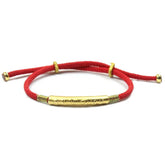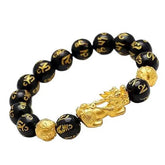Symbolic Meaning and Benefits of Wearing a Tree of Life Pendant
Are you seeking to deepen your connection with the natural world? Are you interested in adding a powerful symbolic piece of jewelry to your collection? The Tree of Life pendant offers an enchanting and profound way to express yourself while honoring the splendor of nature. Symbolizing everything from life and renewal to eternity, this exquisite accessory serves as a beautiful reminder that we are part of something greater than ourselves. Worn for centuries across diverse cultures worldwide, these necklaces carry deep significance that transcends generations. In this blog post, let's delve into what makes these pieces so unique and how they can enrich our lives with blessings.
The Tree of Life Meaning
The Tree of Life stands as a potent symbol across numerous spiritual traditions, embodying the profound interconnectedness between the celestial and terrestrial realms, as well as the unity of all living beings on our planet.
Within Buddhism, this iconic tree holds paramount significance, representing enlightenment and wisdom at the core of their belief system. It serves as a focal point for introspection, enabling practitioners to delve into the depths of their inner selves and attain liberation from the shackles of suffering and worldly attachments.
Throughout history, diverse cultures have employed this ancient symbol for various purposes, including symbolizing fertility and abundance. Yet, its true essence lies in its spiritual connotation, symbolizing cosmic equilibrium and unity through its interwoven branches extending skyward and grounding into earthly domains.
Functioning as a conduit between the physical realm and divine energies, the Tree of Life facilitates profound insights and comprehension into one's spiritual journey. As we navigate the labyrinth of self-discovery, this symbol serves as a guiding light, illuminating our quest for enlightenment and inner peace. It imbues us with hope amidst adversity, urging us to transcend the superficial and embrace the transformative power of uncertainty.
By acknowledging our intrinsic connection to the vast expanse beyond ourselves, we unlock the gates to a life infused with faith rather than fear. Through acceptance, we liberate ourselves from the constraints of judgment and expectation, embracing our authentic selves with boundless freedom and grace.
The Tree of Life Symbolism
The Tree of Life symbol transcends mere antiquity; it serves as a wellspring of spiritual enlightenment, offering profound insights and understanding across cultures and epochs.
Across history and diverse cultures, this emblem has served as a poignant representation of the interconnectedness inherent in all living beings. From the tenets of Buddhism to the teachings of Christianity, the symbolism of the Tree of Life resonates deeply within numerous religious traditions worldwide.
Embedded within its branches is a rich tapestry of meaning that endures through the ages. In Buddhist philosophy, the Tree of Life signifies the manifold paths leading towards enlightenment, underscoring the transformative potential of mindful introspection and practice.
It stands as a tangible reminder that every arduous journey can be traversed with diligence and contemplation. Acting as a conduit between the material and spiritual realms, the Tree of Life serves as a symbolic bridge, offering seekers passage to higher realms of consciousness.
In Judaism and Christianity alike, the Tree of Life embodies the acquisition of divine knowledge and wisdom through revelations bestowed by God. In the Christian narrative, the tree in paradise symbolizes the bestowal of eternal life upon Adam and Eve, signifying their newfound awareness granted by the divine.
This narrative serves as a poignant testament to the profound significance of trees in our spiritual landscape, offering us a beacon of hope and transcendence beyond the confines of our mortal existence. Through heeding their teachings, we are offered a glimpse into a realm greater than ourselves, steeped in divine wisdom and grace.
The Tree Of Life Symbolism In Different Cultures
Buddhism
Within the realm of Buddhism, the Bodhi Tree holds a sacred status as the locus of Siddhartha Gautama's enlightenment, leading to his transformation into the Buddha. This revered tree, known as the tree of life, symbolizes the virtues of wisdom, enlightenment, and tranquility within the Buddhist tradition.
Christianity
According to Christian belief, the tree of life originally existed within the Garden of Eden.
In the narrative, Adam and Eve were initially intended to dwell eternally in this paradisiacal setting. However, upon succumbing to sin, they were expelled from the Garden and faced mortality.
Yet, with the advent of Jesus Christ and his sacrificial death on the cross, the burden of sin was lifted from humanity.
Consequently, Christians hold the conviction that through Christ's redemption, they regain access to the tree of life, thus securing the promise of eternal life in paradise.
Hinduism
Within Hinduism, the Banyan Tree carries profound importance as it is perceived as the primal source from which all creation emanates. This celestial tree serves as a pivotal metaphor, symbolizing the intertwining pathways that link the physical and metaphysical realms, bridging the gap between heaven and earth.
The Mayans
Symbols representing the Tree of Life are prevalent among ancient Mesoamerican civilizations, including the Mayans. They utilized these symbols to comprehend the cyclical patterns of nature, such as the transition from day to night and the shifting seasons, aiming to establish a harmonious equilibrium between humanity and the natural world.
Ancient Egypt
In ancient Egyptian culture, trees held significant symbolism, evidenced by their depiction on tombs and temples. These representations underscored the Egyptians' belief in their divine connection, asserting their authority over earthly domains.
Others
The concept of a sacred tree unifying diverse realms resonates across various philosophical and religious traditions, spanning from Eastern philosophies like Taoism to Western faiths like Judaism. Throughout history and into the present day, symbols of the tree embody virtues such as resilience, longevity, and spiritual renewal, embodying enduring significance across cultural boundaries.
Regardless of cultural origin, these potent symbols remain deeply ingrained within our collective consciousness, transcending mere representation to offer profound insights into our spiritual and physical existence in the contemporary world.
What Does It Mean to Wear a Tree of Life Pendant?
Jewelry has adorned humanity throughout history, evolving alongside us. Today, it serves not only as decoration but also as a means of self-expression, reflecting our beliefs and values. Among the most popular pieces is the Tree of Life pendant, celebrated for its symbolism and growing popularity in recent times. Let's delve into what wearing this pendant signifies and why it resonates with so many people today.
The Tree of Life necklace holds diverse meanings across cultures, universally symbolizing life, growth, and resilience. It embodies the interconnectedness of all beings and signifies the perpetual cycle of life. Wearing a Tree of Life necklace is a tribute to the intricate and diverse ecosystem that sustains us all.
Wearing a Tree of Life necklace serves as a poignant reminder of cherished values and beliefs. It prompts us to cherish and safeguard the environment, embrace diversity, and recognize our interconnectedness with others. This symbolic jewelry also honors ancestry and roots, commemorating departed family members while celebrating new beginnings in our families and communities.
Beyond its profound symbolism, the Tree of Life necklace has emerged as a prominent fashion trend in recent years. As more individuals seek to express their values through fashion, this necklace has become a favored accessory. Available in a myriad of styles and designs, it blends seamlessly with various wardrobes, offering versatility and aesthetic appeal.
In essence, the Tree of Life necklace intertwines fashion with symbolism. It resonates deeply with our values and connections, symbolizing the eternal cycle of life. Whether worn to honor the past or celebrate new growth, this necklace transcends mere adornment—it embodies vitality, resilience, and cultural significance. If you're seeking a jewelry piece that marries fashion with profound meaning, the Tree of Life necklace stands as a fitting choice for anyone.
Benefits of Wearing the Tree of Life Pendant
Jewelry serves as a wonderful means to express your individual style and personality. For those drawn to natural-looking pieces rich in spiritual symbolism, the Tree of Life necklace or bracelet may be an ideal choice. This ancient symbol spans diverse cultures globally, embodying themes of vitality, resilience, and the profound interconnection among all living beings. Delving deeper into the significance of the Tree of Life reveals compelling reasons why incorporating it into your wardrobe can be meaningful and enriching.
1. Natural Mind-body Connection
Trees play a vital role in our lives by providing oxygen, shelter, and a bounty of herbs and fruits that contribute to our health. Wearing the Tree of Life jewelry connects you to nature, anchoring you in spiritual energy. It fosters a lifestyle of wellness, encouraging healthy choices and enhancing overall well-being.
2. A Reminder or Personal Growth
Like trees that annually grow from the earth to create expansive canopies shielding us from the elements, the Tree of Life serves as a symbol of personal growth and development. It reminds us of life's resilience and the constant availability of new opportunities for growth. Wearing a Tree of Life necklace or bracelet can inspire you to embrace new challenges and overcome obstacles in your journey.
3. Spiritual Significance
Across diverse cultures, the tree of life carries profound spiritual meaning, symbolizing the eternal cycle of life, death, and renewal. Its roots embody the past, its trunk signifies the present, and its branches extend into the future. Wearing tree of life jewelry fosters a sense of connection to the divine and reinforces our place as a small yet integral part of the vast universe.
4. A Timeless Fashion Piece
The tree of life pendant or bracelet transcends mere fashion; it embodies timeless elegance. Its design, simple yet refined, surpasses fleeting trends. Whether you're strolling through a park or attending a formal event, this versatile accessory complements any outfit effortlessly. With its striking appeal, it promises to elevate your style.
5. A Meaningful Gift
Tree of life jewelry makes an exceptional gift for someone special. It symbolizes appreciation for their personal growth and the spiritual bond you share. Whether given for a birthday, anniversary, or to celebrate an achievement, it serves as a lasting reminder of your connection and support.
Wearing a tree of life necklace or bracelet goes beyond fashion—it's a way to connect with spirituality and stay grounded in nature. It encourages healthy living, reflects personal growth, holds deep spiritual meaning, and stands as a timeless accessory. Embrace the tree of life and enrich your jewelry collection today.
Is Wearing a Tree of Life Symbol Lucky?
Wearing a Tree of Life pendant or charm can enhance your sense of connection to the universe, fostering positivity and potentially improving your mood and overall well-being. Many individuals attest that wearing Tree of Life jewelry has aided them in overcoming obstacles and reaching their goals.
Wearing a Tree of Life bracelet or pendant can serve as a meaningful and powerful accessory, reminding you of your faith, values, and spiritual beliefs. Give it a try and see if it brings you the luck and positivity you seek.
Conclusion
In conclusion, the Tree of Life symbol boasts a multifaceted and intricate history, adorned with myriad interpretations.
Across diverse cultures, it serves as a potent emblem, symbolizing an array of life's facets, spanning from physical nourishment to spiritual awakening.
Irrespective of its cultural context or assigned significance, the Tree of Life persists as a profound symbol, eloquently illustrating the interwoven fabric of existence.
I'm captivated by the enduring potency of this ancient symbol and eagerly anticipate delving deeper into its significance in the years ahead.








Leave a comment
All blog comments are checked prior to publishing